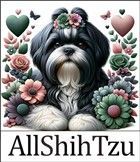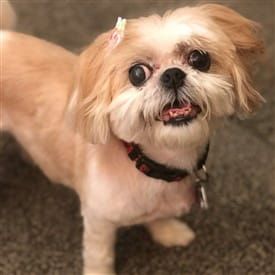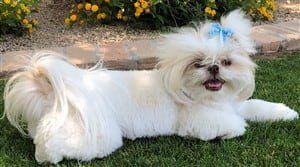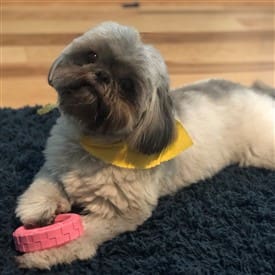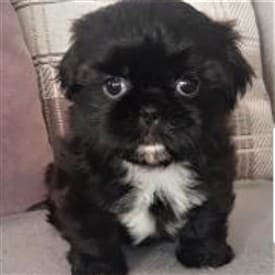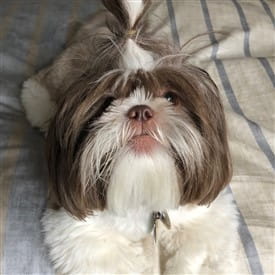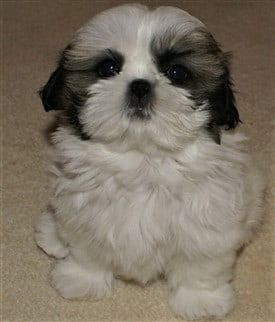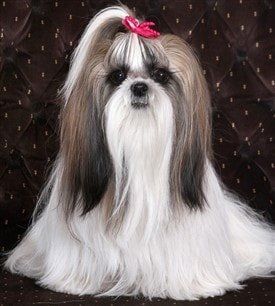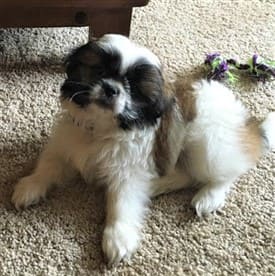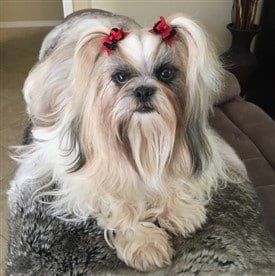Physical Changes that Happen During the First Year
Newborn Shih Tzu puppies are just mere ounces (under a pound). By the time an 8-week old is ready to transition to their new home, they are generally between 1 and 3 pounds (.45 to 1.36 kg). Many reach their full adult size by the 9 to 10-month mark. The AKC standard for weight calls out for 9 to 16 lbs. (4 to 7.3 kg) which is realistic (some breed standards are not);however, a more accurate range for pets (not those in show) is between 7 and 20 lbs. (3.2 to 9 kg).
Shih Tzu dogs will, of course, also sprout up in height. The height of an 8-week-old Shih Tzu puppy is generally in the range of 3 to 4 inches (8.89 to 10.16 cm) as measured from the floor to the withers (which are the top of the shoulder blades).
When a Shih Tzu reaches their full adult size around the 10-month mark, the typical height is a range of 8 to 11 inches (20.3 to 27.9 cm) as measured from the floor to the withers. As per the AKC breed standard, the 'ideal' height for the conformation show ring is 9 to 10.5 inches (22.86 to 26.67 cm).
Overall Body Shape and Fat Distribution:
Young puppies have rather round bodies with short limbs and a moderate amount of fat stores. Adults are longer and leaner, though they are considered to be a compact, sturdy dog. The breed in general is slightly longer (from withers to the root of the tail) than they are tall (floor to withers).
This breed can be found in such a wonderful range of colors. But, don't fall in love with the color of your new 8-week-old Shih Tzu puppy since there can be lots of changes that take place over the first year or so. In many cases, colors will fade down (though in some instances it can deepen) and patterns or markings (like brindle or spotting) will decrease, sometimes to the point of completely fading off (though in some cases, this can intensify).
By the 1-year-mark, what you see will most likely be a Shih Tzu's final coloring and markings; but UV sun exposure can also affect the coat, causing colors to fade over time.
Skin points on a dog are the nose, paw pads, eye rims, and lips. Typically, these are all one certain color (for example, you will not commonly find a black nose paired with liver-colored paw pads). But, the intensity of the color can vary from point to point.
With the Shih Tzu breed, skin pigmentation can be black (very common), liver (the second most common), or blue (rare). There are also parti-noses that have varying levels of pink along with another color (spotted) and this can look super-cute (but is considered a fault in the show ring).
As a Shih Tzu matures from a puppy into an adult, their nose and other skin points can change to a certain degree. This can be due to genetics, to environmental factors, or a combination of both.
In regard to genetics, there is a limit to the changes that can occur. A liver can change from a deep dark liver that appears dark brown to a light liver that has a pink or light purple sheen or vice-versa; but, that liver could not transform into a blue or black nose. And the same goes for the other possible skin pigmentation hues.
In regard to environmental factors, a few things can cause the nose to lose it's deep color or become spotty. A common cause is long-term contact with plastic bowls (even those that are BPA-free). Numerous times, when an adult Shih Tzu's nose has become discolored or faded, and owners switch to a a
good stainless-steel bowl, things move into the other direction and eventually color comes back.
Another common factor is outdoor exposure. Too much sun can cause a burn and cold winds can cause chapping. Both of these things can lead to peeling skin. When the top layer peels away it can expose a lighter (or pink) layer. This can also be
very
tender.
If your Shih Tzu's nose needs protection, you can dab a bit of balm like
Natural Dog Company's Snout Soother

onto it every 2 to 3 days (and every day to help heal issues like peeling or cracking).
Alternatively, not enough sun can cause winter nose (AKC snow nose), a common issue seen with dogs in the wintertime when there are fewer daylight hours. Typically in these cases, once spring and summer come around, the nose darkens up again.
Adorable Age Progression Photos of Shih Tzu Puppies Maturing
There are a lot of changes that happen as Shih Tzu puppies mature into adults. Let's look at some awesome puppy-to-adult photos.
First, here are several cutie pies that had very noticeable color changes as they matured from puppies to adults...
and, as expected, they sprouted up from round pups to leaner, longer, and taller adults.
